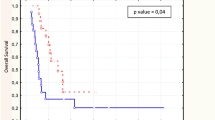Abstract
Background
The role and potential usefulness of positron emission tomography (PET) scanning in certain tumors has been widely investigated in recent years. 18F-FAMT (L-[3-18F]-α-methyltyrosine) is an amino acid tracer for PET. This study investigated whether PET/CT with 18F-FAMT provides additional information for preoperative diagnostic workup of esophageal squamous cell carcinoma compared with that obtained by 18F-FDG (fluorodeoxyglucose) PET or CT.
Methods
PET/CT studies with 18F-FAMT and 18F-FDG were performed as a part of the preoperative workup in 21 patients with histologically confirmed esophageal squamous cell carcinoma.
Results
For the detection of primary esophageal cancer, 18F-FAMT-PET exhibited a sensitivity of 76.2%, whereas the sensitivity for 18F-FDG-PET was 90.5% (P = 0.214). 18F-FAMT uptake in primary tumors showed significant correlation with depth of invasion (P = 0.005), lymph node metastasis (P = 0.045), stage (P = 0.031), and lymphatic invasion (P = 0.029). In the evaluation of individual lymph node groups, 18F-FAMT-PET exhibited 18.2% sensitivity, 100% specificity, 71.9% accuracy, 100% positive predictive value, and 70.0% negative predictive value, compared with 24.2%, 93.7%, 69.8%, 66.6%, and 70.2%, respectively, for 18F FDG-PET. CT exhibited 39.4% sensitivity, 85.7% specificity, 69.8% accuracy, 59.1% positive predictive value, and 73.0% negative predictive value. The specificity of 18F-FAMT-PET is significantly higher than that of 18F-FDG-PET (P = 0.042) and CT (P = 0.002). 18F-FAMT-PET did not have any false-positive findings compared to those with 18F-FDG-PET.
Conclusions
Our findings suggest that the addition of 18F-FAMT-PET to 18F-FDG-PET and CT would permit more precise staging of esophageal cancer.



Similar content being viewed by others
References
Daly JM, Karnell LH, Menck HR. National Cancer Data Base report on esophageal carcinoma. Cancer. 1996;78:1820–8.
Wobst A, Audisio RA, Colleoni M, Geraghty JG. Oesophageal cancer treatment: studies, strategies and facts. Ann Oncol. 1998;9:951–62.
Kato H, Kuwano H, Nakajima M, et al. Comparison between positron emission tomography and computed tomography in the use of the assessment of esophageal carcinoma. Cancer. 2002;94:921–8.
Brock CS, Meikle SR, Price P. Does fluorine-18 fluorodeoxyglucose metabolic imaging of tumours benefit oncology? Eur J Nucl Med. 1997;24:691–705.
Kato H, Takita J, Miyazaki T, et al. Correlation of 18-F-fluorodeoxyglucose (FDG) accumulation with glucose transporter (Glut-1) expression in esophageal squamous cell carcinoma. Anticancer Res. 2003;23:3263–72.
Kato H, Nakajima M, Sohda M, et al. The clinical application of 18F-fluorodeoxyglucose positron emission tomography to predict survival in patients with operable esophageal cancer. Cancer. 2009;115:3196–203.
Tomiyoshi K, Amed K, Muhammad S, et al. Synthesis of isomers of 18F-labelled amino acid radiopharmaceutical: position 2- and 3-L-18F-alpha-methyltyrosine using a separation and purification system. Nucl Med Commun. 1997;18:169–75.
Inoue T, Tomiyoshi K, Higuichi T, et al. Biodistribution studies on L-3-[fluorine-18]fluoro-alpha-methyl tyrosine: a potential tumor-detecting agent. J Nucl Med. 1998;39:663–7.
Amano S, Inoue T, Tomiyoshi K, Ando T, Endo K. In vivo comparison of PET and SPECT radiopharmaceuticals in detecting breast cancer. J Nucl Med. 1998;39:1424–7.
Uchino H, Kanai Y, Kim DK, et al. Transport of amino acid-related compounds mediated by L-type amino acid transporter 1 (LAT1): insights into the mechanisms of substrate recognition. Mol Pharmacol. 2002;61:729–37.
Kim DK, Kanai Y, Choi HW, et al. Characterization of the system L amino acid transporter in T24 human bladder carcinoma cells. Biochim Biophys Acta. 2002;1565:112–21.
Kaira K, Oriuchi N, Otani Y, et al. Diagnostic usefulness of fluorine-18-alpha-methyltyrosine positron emission tomography in combination with 18F-fluorodeoxyglucose in sarcoidosis patients. Chest. 2007;131:1019–27.
Kaira K, Oriuchi N, Otani Y, et al. Fluorine-18-alpha-methyltyrosine positron emission tomography for diagnosis and staging of lung cancer: a clinicopathologic study. Clin Cancer Res. 2007;13:6369–78.
Kaira K, Oriuchi N, Shimizu K, et al. Evaluation of thoracic tumors with 18F-FMT and 18F-FDG PET-CT: a clinicopathological study. Int J Cancer. 2009;124:1152–60.
Japanese Society for Esophageal Disease. Guidelines for the clinical and pathological studies on carcinoma of the esophagus. 10th ed. Tokyo: Kanehara; 2008.
Hamacher K, Coenen HH, Stöcklin G. Efficient stereospecific synthesis of no-carrier-added 2-[18F]-fluoro-2-deoxy-d.-glucose using aminopolyether supported nucleophilic substitution. J Nucl Med. 1986;27:235–8.
Beck JR. Likelihood ratios. Another enhancement of sensitivity and specificity. Arch Pathol Lab Med. 1986;110:685–6.
Kuwano H, Sumiyoshi K, Sonoda K, et al. Relationship between preoperative assessment of organ function and postoperative morbidity in patients with oesophageal cancer. Eur J Surg. 1998;164:581–6.
Bar-Shalom R, Valdivia AY, Blaufox MD. PET imaging in oncology. Semin Nucl Med. 2000;30:150–85.
Meltzer CC, Luketich JD, Friedman D, et al. Whole-body FDG positron emission tomographic imaging for staging esophageal cancer comparison with computed tomography. Clin Nucl Med. 2000;25:882–7.
Flamen P, Lerut A, Van Cutsem E, et al. Utility of positron emission tomography for the staging of patients with potentially operable esophageal carcinoma. J Clin Oncol. 2000;18:3202–10.
Acknowledgment
We thank Dr. Keisuke Ieta, Dr. Yasuyuki Fukai, Dr. Ryokuhei Manda, Dr. Hitoshi Ojima, and Dr. Katsuhiko Tsukada for valuable cooperation, and Ms. Tomoko Yano, Ms. Hideko Emura, Ms. Midori Ohno, Ms. Miwako Ida, and Ms. Yukie Saito for their excellent secretarial assistance.
Author information
Authors and Affiliations
Corresponding author
Rights and permissions
About this article
Cite this article
Sohda, M., Kato, H., Suzuki, S. et al. 18F-FAMT-PET Is Useful for the Diagnosis of Lymph Node Metastasis in Operable Esophageal Squamous Cell Carcinoma. Ann Surg Oncol 17, 3181–3186 (2010). https://doi.org/10.1245/s10434-010-1177-y
Received:
Published:
Issue Date:
DOI: https://doi.org/10.1245/s10434-010-1177-y




